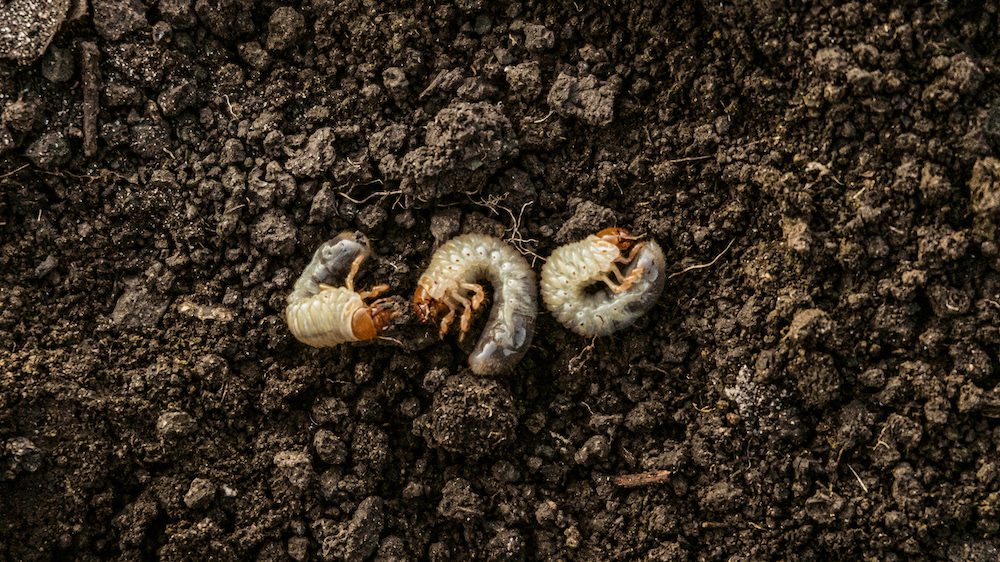
Ian Dyball/Getty Images
Have you noticed any dead or spongy patches of grass on your lawn lately? They could be the work of garden grubs. While these gross little wormlike creatures are harmless to humans, they may murder the heck out of your garden.
Brown grass or clusters of dead plants are always concerning for homeowners. But if you haven’t been hit with a nasty drought lately, or doused your lawn in toxic chemicals, you may be playing host to these unwelcome pests.
Here’s the low-down on everything you need to know about garden grubs, and how to kick them out of your yard.
What’s a garden grub?

N-sky/Getty Images
Garden grubs are essentially baby beetles, but that doesn’t mean they’re cute. You’d probably prefer to see these writhing white larvae on the opposite end of a fishing pole.
“Lawn and garden grubs are juvenile scarab beetles,” says Dan Bailey, president of WikiLawn. “They get into your lawn when an adult beetle lays eggs, usually a few inches into the soil. When they hatch and progress beyond the larval stage, they begin eating grass roots.”
But before you start googling “scarab beetle,” hear this. Scarab refers to the Scarabaeidae family of beetles, which has 30,000 species.
“There are many different kinds,” says Kristiana Kripena of InsectCop. “Most commonly encountered ones are the larvae of June bugs, European chafers, masked chafers, billbugs, Oriental beetles, and Japanese beetles.”
Whatever the type, without your own personal Timon and Pumbaa, you’ll need to mount a serious plan of attack to get rid of these grubs.
How do I know if I have grubs?
If you haven’t met the little buggers personally (which would be likely to happen as you are digging around in your lawn or garden) it can be hard to know for sure when you have them. Here are a few ways to identify these stealthy pests.
“Grubs always have a C-shaped body, brown head, and three pairs of legs,” says Gina Harper of Harper’s Nurseries. “Grubs feed on roots, so if you see [that] a patch of grass lifts without roots holding it down, or brown spots that never turn green and an increase in activity from birds, raccoons, and skunks—that means you have a grub problem.”
You should also become suspicious if you start seeing an increased beetle population in your yard, especially if your lawn starts mysteriously dying a year after you first spot them.
“Grub problems occur in a regular three-year cycle if not managed,” says Harper. “The most significant damage occurs the year after the appearance of the beetles.”
How to get rid of garden grubs
These nasty little things can be a real pain to get rid of. Fortunately, there are some tried and true methods that actually work. And none of these methods involve illegally importing any meerkats or warthogs. Hakuna matata!
Nematodes
If you know for a fact that larvae are feasting on your grass, then it’s time to head to your local gardening store (or Amazon) and pick up some beneficial nematodes.
“The most effective and natural way of getting rid of grubs is using beneficial nematodes,” says Harper.
These microscopic worms may sound benign, but they’re actually one of the best solutions for killing your garden grubs. Here’s how they get the job done: Once in the soil, nematodes will seek out your unwanted guests and infect them with a potent bacteria that kills them in 48 hours or less.
Milky spore
Another natural way to kill your garden grubs is using something called milky spore ($40, Lowe’s). However, it only works on Japanese beetles—meaning that you need to know what kind of grub you’re dealing with.
Here’s how it gets down to business.
“Once grubs eat the milky spore, it will reproduce inside the larva, eventually killing them, in seven to 21 days,” says Harper. “As the grub decomposes, it will release new spores that multiply and kill other grubs.”
Drought
Beyond the classic nematode or milky spore method, we’ve also heard of people trying a self-inflicted drought to rid their yard of grubs.
“The eggs prefer damp environments and will die if they don’t get water,” says Kripena. “Therefore, not watering the lawn will help with the problem.”
Definitely what we’d call a scorched-earth solution.
One method to stay away from? Aeration—aka the ultra-sophisticated practice of poking holes in your lawn to make it grow better.
“Aerating the lawn is not a great way to deal with the issue, as it won’t really eradicate the pests,” says Kripena.
Sure, you might kill a few, but not enough to solve the problem. And trust us on this one, grubs are a bit like Pokemon. You gotta catch ’em all.
The post Garden Grubs: How To Slay the Nasty Worms in Your Yard appeared first on Real Estate News & Insights | realtor.com®.
No comments:
Post a Comment